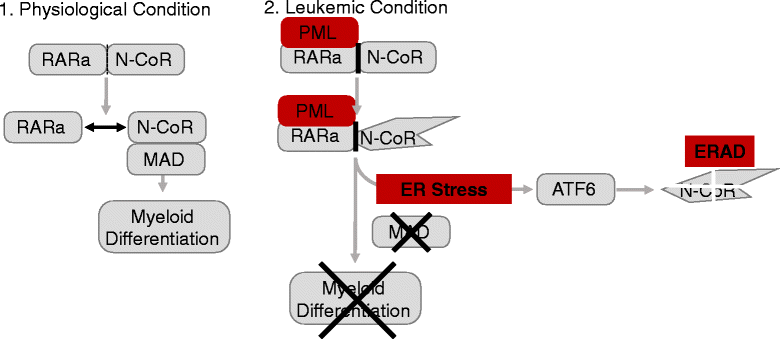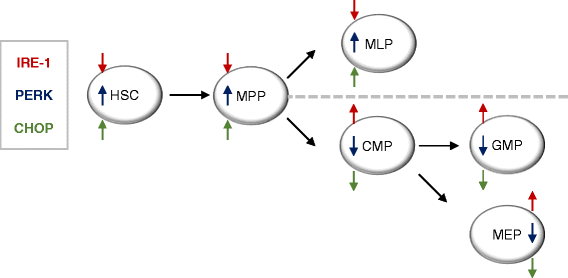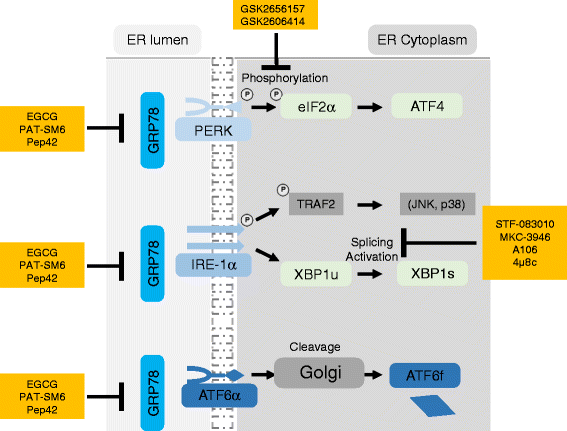Drugging the unfolded protein response in acute leukemias
- PMID: 26179601
- PMCID: PMC4504168
- DOI: 10.1186/s13045-015-0184-7
Drugging the unfolded protein response in acute leukemias
Abstract
The unfolded protein response (UPR), an endoplasmic reticulum (ER) stress-induced signaling cascade, is mediated by three major stress sensors IRE-1α, PERK, and ATF6α. Studies described the UPR as a critical network in selection, adaptation, and survival of cancer cells. While previous reviews focused mainly on solid cancer cells, in this review, we summarize the recent findings focusing on acute leukemias. We take into account the impact of the underlying genetic alterations of acute leukemia cells, the leukemia stem cell pool, and provide an outline on the current genetic, clinical, and therapeutic findings. Furthermore, we shed light on the important oncogene-specific regulation of individual UPR signaling branches and the therapeutic relevance of this information to answer the question if the UPR could be an attractive novel target in acute leukemias.
Figures



Similar articles
-
The Unfolded Protein Response: A Novel Therapeutic Target in Acute Leukemias.Cancers (Basel). 2020 Feb 1;12(2):333. doi: 10.3390/cancers12020333. Cancers (Basel). 2020. PMID: 32024211 Free PMC article. Review.
-
Protein kinase CK2 protects multiple myeloma cells from ER stress-induced apoptosis and from the cytotoxic effect of HSP90 inhibition through regulation of the unfolded protein response.Clin Cancer Res. 2012 Apr 1;18(7):1888-900. doi: 10.1158/1078-0432.CCR-11-1789. Epub 2012 Feb 20. Clin Cancer Res. 2012. PMID: 22351691
-
TMEM33: a new stress-inducible endoplasmic reticulum transmembrane protein and modulator of the unfolded protein response signaling.Breast Cancer Res Treat. 2015 Sep;153(2):285-97. doi: 10.1007/s10549-015-3536-7. Epub 2015 Aug 13. Breast Cancer Res Treat. 2015. PMID: 26268696 Free PMC article.
-
Expression of citrate carrier gene is activated by ER stress effectors XBP1 and ATF6α, binding to an UPRE in its promoter.Biochim Biophys Acta. 2015 Jan;1849(1):23-31. doi: 10.1016/j.bbagrm.2014.10.004. Epub 2014 Oct 27. Biochim Biophys Acta. 2015. PMID: 25450523
-
The paradox of the unfolded protein response in cancer.Anticancer Res. 2013 Nov;33(11):4683-94. Anticancer Res. 2013. PMID: 24222102 Review.
Cited by
-
Molecular subtyping of acute myeloid leukemia through ferroptosis signatures predicts prognosis and deciphers the immune microenvironment.Front Cell Dev Biol. 2023 Aug 24;11:1207642. doi: 10.3389/fcell.2023.1207642. eCollection 2023. Front Cell Dev Biol. 2023. PMID: 37691822 Free PMC article.
-
ER Stress and Unfolded Protein Response in Leukemia: Friend, Foe, or Both?Biomolecules. 2021 Jan 30;11(2):199. doi: 10.3390/biom11020199. Biomolecules. 2021. PMID: 33573353 Free PMC article. Review.
-
VAS3947 Induces UPR-Mediated Apoptosis through Cysteine Thiol Alkylation in AML Cell Lines.Int J Mol Sci. 2020 Jul 31;21(15):5470. doi: 10.3390/ijms21155470. Int J Mol Sci. 2020. PMID: 32751795 Free PMC article.
-
Unfolded Protein Response of the Endoplasmic Reticulum in Tumor Progression and Immunogenicity.Oxid Med Cell Longev. 2017;2017:2969271. doi: 10.1155/2017/2969271. Epub 2017 Dec 21. Oxid Med Cell Longev. 2017. PMID: 29430279 Free PMC article. Review.
-
Deregulated expression of the HSP40 family members Auxilin-1 and -2 is indicative of proteostasis imbalance and predicts patient outcome in Ph(+) leukemia.Exp Hematol Oncol. 2016 Feb 9;5:5. doi: 10.1186/s40164-016-0034-5. eCollection 2015. Exp Hematol Oncol. 2016. PMID: 26862466 Free PMC article.
References
-
- Hetz C. The unfolded protein response: controlling cell fate decisions under ER stress and beyond. Nat Rev Mol Cell Biol. 2012;13(2):89–102. - PubMed
Publication types
MeSH terms
LinkOut - more resources
Full Text Sources
Other Literature Sources
Medical

